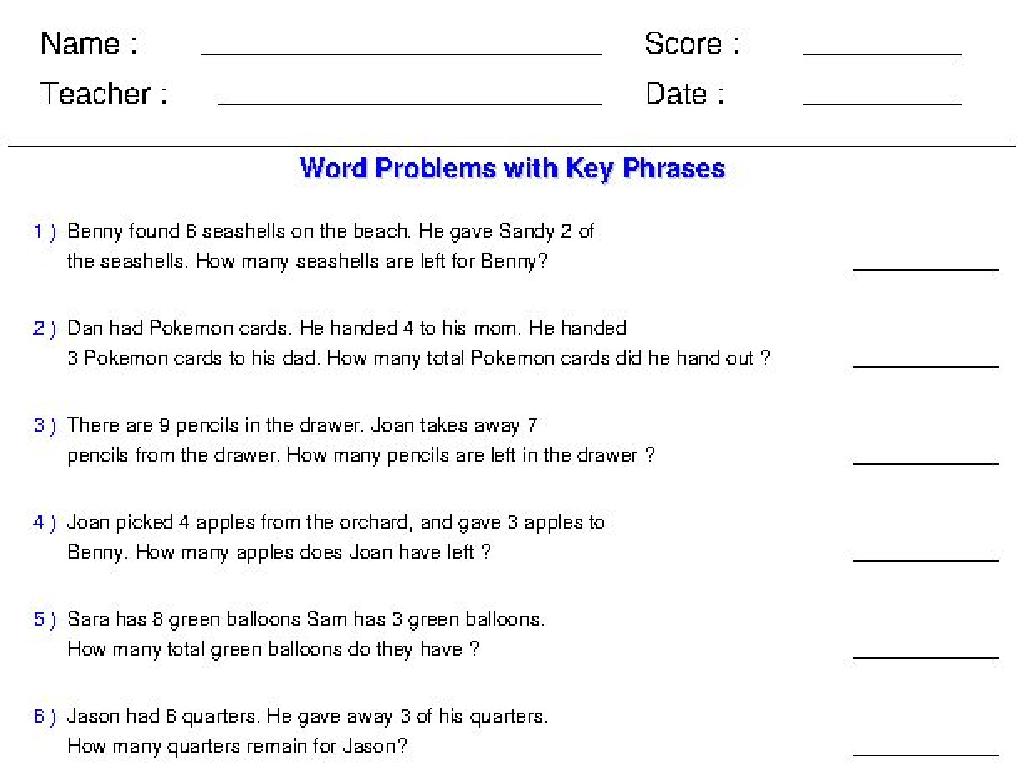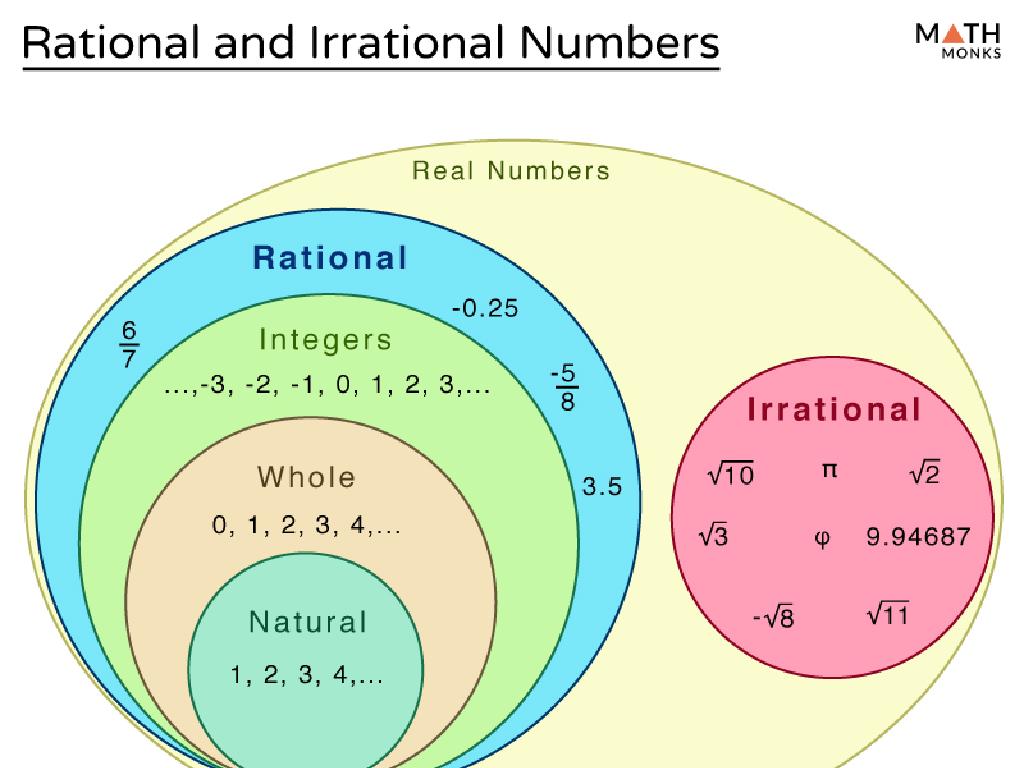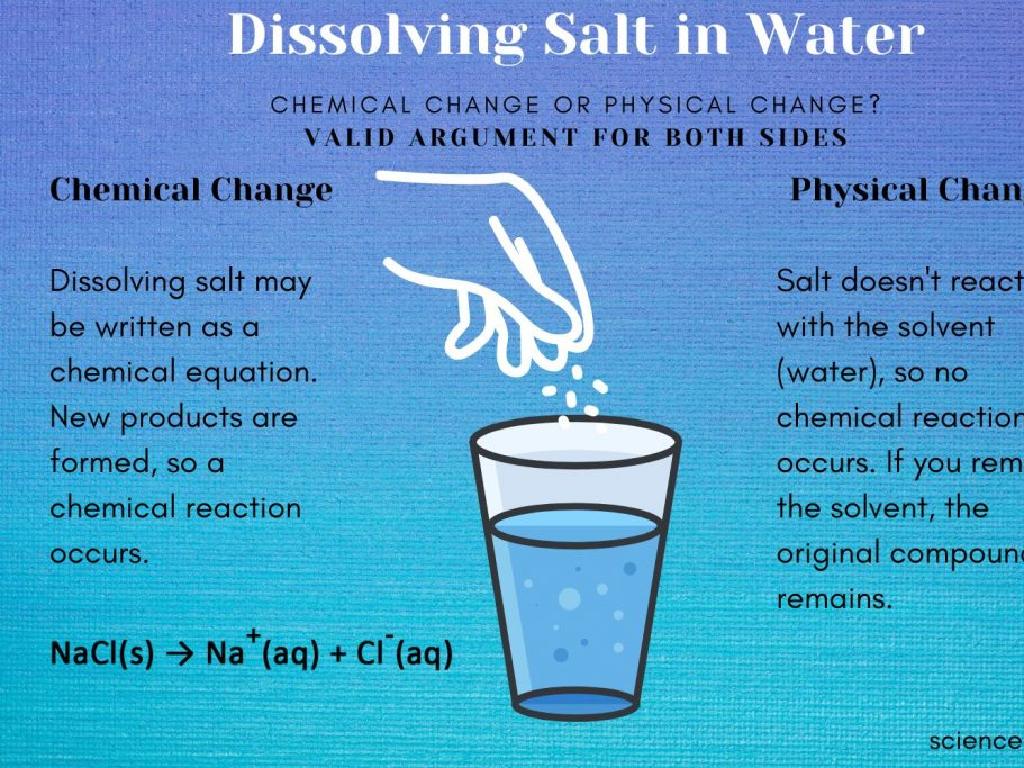Add Fractions With Unlike Denominators Using Models
Subject: Math
Grade: Fifth grade
Topic: Add And Subtract Fractions
Please LOG IN to download the presentation. Access is available to registered users only.
View More Content
Introduction to Adding Fractions
– Recap: What are fractions?
– Fractions represent parts of a whole, like 1/2 a pizza.
– Adding fractions explained
– Combining fractions means putting parts together.
– Adding with different denominators
– We find a common denominator to add fractions that are different.
– Why learn this skill?
|
Begin with a quick review of what fractions are, ensuring students recall that fractions represent parts of a whole. Move on to explain that adding fractions is like combining parts to make a larger part or whole. Emphasize the importance of having a common denominator when adding fractions with unlike denominators, as it allows for an accurate combination of the parts. Explain that this skill is essential for many real-life applications, such as cooking, dividing up resources, or dealing with money. Provide visual aids like pie charts or fraction bars to help students visualize the concept. Encourage students to think of situations where they might need to add fractions in their daily lives.
Visualizing Fractions with Models
– Understanding fractions via models
– Models like pictures help us see the parts of a whole.
– Exploring pie, line, and bar models
– Pie charts show parts of a circle, number lines mark fractions on a line, and bar models divide a rectangle into equal parts.
– Models’ role in adding fractions
– By aligning models, we can visually combine fractions to find a sum.
|
This slide introduces students to the concept of using visual models to understand and add fractions with unlike denominators. Begin by explaining that models are tools that help us picture mathematical concepts. Show examples of pie charts, number lines, and bar models, and discuss how each represents fractions. Demonstrate how to use these models to find a common denominator and visually add fractions by combining the models. This visual approach helps students grasp the abstract concept of adding fractions with unlike denominators, making it more concrete and understandable. Encourage students to draw their own models and use them to add fractions as a class activity.
Identifying Unlike Denominators
– Understanding denominators
– Denominators are the bottom numbers in fractions that show into how many parts the whole is divided.
– ‘Unlike denominators’ explained
– When two fractions have different numbers at the bottom, they have ‘unlike denominators’.
– Examples with unlike denominators
– 1/2 and 3/4 have unlike denominators (2 and 4).
– Visualizing with models
– Use fraction circles or bars to see how different denominators divide the whole differently.
|
This slide introduces the concept of denominators and unlike denominators, which is crucial for understanding how to add fractions with different bottom numbers. Begin by explaining that the denominator represents the total number of equal parts the whole is divided into. Then, clarify that ‘unlike denominators’ means the denominators of the fractions are not the same. Provide clear examples of unlike denominators, such as 1/2 and 3/4, and encourage students to visualize these fractions using models like fraction circles or bars. This will help them grasp why fractions need to have the same denominator before they can be added together. The visual aids will be particularly helpful for students to understand the concept of equivalent fractions in the next lesson.
Making Denominators Alike
– Understand Least Common Denominator
– LCD is the smallest number that all denominators can divide into.
– Find the LCD for fractions
– Compare denominators to determine the smallest common multiple.
– Convert fractions to same denominator
– Multiply numerator and denominator to get equivalent fractions.
– Practice with examples
– Use visual fraction models to see how different fractions relate.
|
This slide introduces the concept of the Least Common Denominator (LCD) as a foundational step in adding fractions with unlike denominators. Begin by explaining that the LCD is the smallest number that all the denominators can divide into without leaving a remainder. Demonstrate how to find the LCD by listing multiples of the denominators and identifying the smallest common one. Once the LCD is found, show students how to convert each fraction to an equivalent fraction with the LCD as the new denominator by multiplying both the numerator and denominator by the same number. Provide several examples and use visual aids like fraction models to help students understand the process. Encourage students to practice this skill with different sets of fractions to become comfortable with the concept.
Adding Fractions with Models
– Step-by-step guide to add fractions
– Example: 1/3 + 2/5 with pie charts
– Visualize fractions as parts of a pie to see the total.
– Importance of same-sized pieces
– Can’t combine different sized pieces; need common size.
– Making denominators the same
– Find a common denominator to add fractions correctly.
|
This slide introduces students to the concept of adding fractions using visual models, such as pie charts. Begin with a step-by-step guide on how to add fractions by finding a common denominator. Use the example of adding 1/3 and 2/5 to illustrate the process. Emphasize the importance of having the same-sized pieces, or denominators, to combine fractions. Explain that we make denominators the same so we can add the numerators directly. This visual approach helps students understand why a common denominator is necessary and how it simplifies the addition of fractions. Encourage students to practice with different models and to create their own examples.
Adding Fractions with Different Denominators
– Example 1: Add 2/4 + 1/6
– Use models to visualize adding two fractions
– Find common denominator for 2/4 and 1/6
– 4 and 6 both fit into 12, so convert fractions to have the same denominator
– Example 2: Add 3/8 + 5/9
– Use models to visualize adding two fractions
– Find common denominator for 3/8 and 5/9
– 8 and 9 both fit into 72, so convert fractions to have the same denominator
|
This slide is designed for a class activity where students will practice adding fractions with unlike denominators using visual models. For Example 1, guide students to find a common denominator by identifying a number that both 4 and 6 can divide into evenly, which is 12. Then, help them convert 2/4 and 1/6 into fractions with a denominator of 12, and add them together. For Example 2, follow a similar process to find a common denominator for 3/8 and 5/9, which is 72. Encourage students to draw models representing each fraction with the new denominators, and then add the models together to find the sum. Provide additional practice problems for students to work on individually or in groups, and be ready to assist any students who need help with the concept.
Class Activity: Fraction Addition Art
– Create fraction addition art
– Use models for unlike denominators
– Use pie charts or number lines to add fractions like 1/3 + 1/4
– Share and explain your art
– Present your art and describe the addition process
– Understand addition with models
– Grasp how different denominators affect addition
|
This activity is designed to help students visualize the concept of adding fractions with unlike denominators. Students will create their own art by representing fractions with models such as pie charts or number lines. They will then add fractions with different denominators using these models. After completing their art, students will share their work with the class and explain the process they used to add the fractions. This will reinforce their understanding and provide an opportunity for peer learning. For the teacher: Prepare materials for creating models, guide students through the process, and ensure each student can articulate their understanding of the addition.
Wrapping Up: Adding Fractions with Unlike Denominators
– Review adding fractions with different denominators
– Understand why practice is key
– Regular practice helps solidify concepts
– Homework: Worksheet completion
– Apply today’s lesson to solve problems
– Be prepared to discuss solutions
– Share your answers and methods in the next class
|
As we conclude today’s lesson, it’s important to recap the steps for adding fractions with unlike denominators using models. Emphasize the importance of practice in mastering this skill. For homework, students are assigned a worksheet that provides additional practice to reinforce what they’ve learned. Encourage students to attempt all problems and be ready to discuss their solutions and the strategies they used during our next class. This will help them understand different approaches to solving the same problem and learn from each other.






